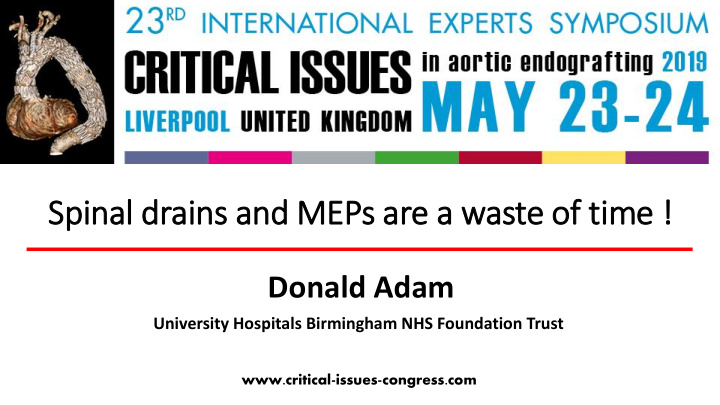



Spin inal drains and MEPs are a waste of tim ime ! Donald Adam University Hospitals Birmingham NHS Foundation Trust www.critical-issues-congress.com
My remit from the course organisers….. How do we achieve low paraplegia rates without spinal drains and MEPs? What is our current spinal cord protocol? Are spinal drains and MEPs ever useful?
+ age, renal insufficiency, long procedures MEPs and CSF drainage (> 48hrs) should be considered in patients undergoing TEVAR at high risk of SCI (extent II and III TAAA, previous aortic surgery, occluded LSA and/or IIA)
142 patients treated for extent II, III and IV TAAA 64 had prophylactic CSF drainage 23 (16%) developed SCI (10 immediate, 13 delayed) 3 (2%) had irreversible paraplegia at discharge Prophylactic CSF drains did not reduce the SCI rate and were associated with a 6% adverse event rate
Spinal Cord Protection Protocol Stop anti-hypertensives pre-operatively Preserve spinal cord collaterals (LSA, IIA) Minimize embolisation, blood loss, lower limb/pelvic IRI Staged procedures HDU care for at least 36 hours post-operatively Maintain MAP > 80mmHg Maintain patient lying at 30 degrees for 36 hrs Maintain CVP <15mmHg Maintain O 2 delivery (Hb >10, pO 2 >9, SaO 2 >95%) Correct coagulopathy Gradual mobilisation and restart anti-hypertensives No prophylactic (only salvage) CSF drainage
270 patients treated with SC coverage 6 (2.2%) non-ambulatory SCI 83 with < 40mm SC coverage none staged, no prophylactic CSF drains = no SCI 187 with > 40mm SC coverage 6 (3.3%) non-ambulatory SCI (3 immediate, 3 delayed) Pre-SCPP: 4 of 20 (20%), none staged, 13 prophylactic CSF drains Post-SCPP: 2 of 167 (1.2%), 89 staged, no prophylactic CSF drains
201 survivors of extent I-V TAAA repair 144 (72%) had prophylactic CSF drains 21 (10%) developed SCI (5 immediate, 16 delayed) 8 (4%) had disabling SCI at 30-days Prolonged procedure > 300 mins, eGFR < 30 - independent predictors of SCI
Q.E.D.
185 patients treated for extent I-IV TAAA 9 (5%) developed SCI - 3 paraparesis, 6 paraplegia (4 immediate, 5 delayed) 4 of 6 paraplegia were extent I-III TAAA
Low paraplegia rates without CSF drains and MEPs Patient selection Preserve spinal cord collaterals (LSA, IIA) Minimize embolisation and lower limb/pelvic IRI Staged (quicker) procedures Maintain MAP > 80mmHg and optimise O 2 delivery CSF drains useful for salvage if no/poor response to elevated MAP > 100mmHg MEPs may be useful if they can - predict immediate and delayed SCI - identify the 20% of patients who should benefit from staging
Recommend
More recommend